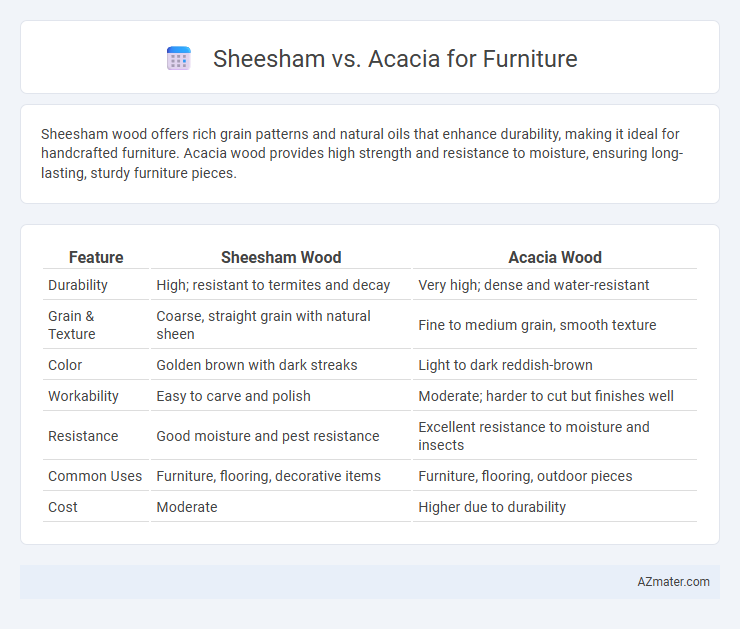Sheesham wood offers rich grain patterns and natural oils that enhance durability, making it ideal for handcrafted furniture. Acacia wood provides high strength and resistance to moisture, ensuring long-lasting, sturdy furniture pieces.
Table of Comparison
| Feature | Sheesham Wood | Acacia Wood |
|---|---|---|
| Durability | High; resistant to termites and decay | Very high; dense and water-resistant |
| Grain & Texture | Coarse, straight grain with natural sheen | Fine to medium grain, smooth texture |
| Color | Golden brown with dark streaks | Light to dark reddish-brown |
| Workability | Easy to carve and polish | Moderate; harder to cut but finishes well |
| Resistance | Good moisture and pest resistance | Excellent resistance to moisture and insects |
| Common Uses | Furniture, flooring, decorative items | Furniture, flooring, outdoor pieces |
| Cost | Moderate | Higher due to durability |
Introduction to Sheesham and Acacia Wood
Sheesham wood, also known as Indian Rosewood, is celebrated for its rich grain patterns, durability, and natural oils that resist decay, making it a popular choice for high-quality furniture. Acacia wood boasts a dense, fine grain with natural water-resistant properties and a warm, honey-toned finish that enhances both indoor and outdoor furniture longevity. Both woods offer exceptional strength and aesthetic appeal, with Sheesham prized for traditional craftsmanship and Acacia favored for its sustainability and versatility.
Botanical Origins and Growth Regions
Sheesham wood, also known as Dalbergia sissoo, is native to the Indian subcontinent, thriving primarily in northern India, Pakistan, and Nepal, characterized by its dense, durable hardwood ideal for furniture. Acacia, belonging to the genus Acacia, is found predominantly in Australia, Africa, and parts of Asia, with species like Acacia mangium and Acacia koa being popular for their fast growth and rich, varied grain patterns. Both woods are prized for their strength and natural beauty, but Sheesham's slow growth in subtropical climates contributes to its tighter grain, while Acacia's adaptability allows for diverse textures in furniture design.
Physical Appearance and Grain Patterns
Sheesham furniture showcases rich, dark brown hues with deep reddish undertones, featuring distinctive swirling grain patterns that create a luxurious and elegant look. Acacia furniture is characterized by warm, golden to medium brown tones with varied grain patterns that range from straight to wavy, adding a rustic and natural charm. The pronounced and contrasting grain in Sheesham highlights craftsmanship details, while Acacia's smoother, more uniform grains emphasize versatility and casual appeal.
Durability and Strength Comparison
Sheesham wood exhibits exceptional durability and strength, making it highly resistant to wear, decay, and insect attacks, ideal for long-lasting furniture. Acacia wood, known for its dense grain and toughness, offers superior strength and excellent resistance to moisture, ensuring robust furniture construction. Both woods provide high durability, but Sheesham's natural oils offer enhanced protection against environmental damage compared to Acacia.
Resistance to Pests and Decay
Sheesham wood exhibits strong natural resistance to pests and decay due to its high oil content, making it ideal for durable furniture in humid environments. Acacia wood also offers impressive pest resistance and moderate decay resistance, but it may require additional treatment for long-term outdoor use. Both woods are sustainable choices, yet Sheesham's superior natural oils provide enhanced protection without chemical preservatives.
Workability and Crafting Ease
Sheesham wood offers excellent workability with its medium density and natural oils that reduce tool wear, making it a preferred choice for intricate furniture crafting. Acacia wood, while harder and more durable, presents a tougher challenge during carving and shaping due to its dense grain structure. Craftsmen often favor Sheesham for delicate designs and detailed finishes, whereas Acacia is chosen for robust furniture requiring high resistance to wear.
Maintenance and Care Requirements
Sheesham wood requires regular oiling and dusting to maintain its rich color and prevent cracks, while Acacia wood demands periodic sealing to protect against moisture and insect damage. Both types benefit from using mild cleaners and avoiding harsh chemicals to preserve their natural finish. Proper maintenance extends the lifespan of Sheesham and Acacia furniture, ensuring their durability and aesthetic appeal in home settings.
Environmental Sustainability Factors
Sheesham wood, sourced primarily from Dalbergia species, is a durable hardwood often harvested from slow-growing trees, raising concerns about deforestation and habitat loss if not sustainably managed. Acacia, known for its fast growth and ability to thrive in degraded soils, offers a more renewable option with lower environmental impact due to quicker carbon sequestration and less intensive harvesting practices. Choosing Acacia furniture supports sustainable forestry initiatives and reduces the ecological footprint compared to Sheesham, which requires strict certification to ensure responsible sourcing.
Price and Market Availability
Sheesham wood, also known as Indian Rosewood, is generally more expensive than Acacia due to its dense grain and durability, making it a premium choice for high-end furniture. Acacia furniture is widely available and more affordable, favored for its natural resistance to decay and attractive grain patterns. Market availability of Sheesham is limited by slower growth rates and export restrictions, while Acacia grows faster and is more readily accessible globally.
Choosing the Right Wood for Your Furniture
Sheesham wood, known for its rich grain and natural resistance to termites, offers durability and a warm, golden-brown hue ideal for classic furniture designs. Acacia wood provides a harder, denser structure with a striking reddish-brown color and excellent water resistance, making it suitable for both indoor and outdoor furniture applications. Choosing between Sheesham and Acacia depends on desired aesthetics, durability needs, and resistance to environmental factors to ensure the best investment for long-lasting furniture.

Infographic: Sheesham vs Acacia for Furniture
 azmater.com
azmater.com